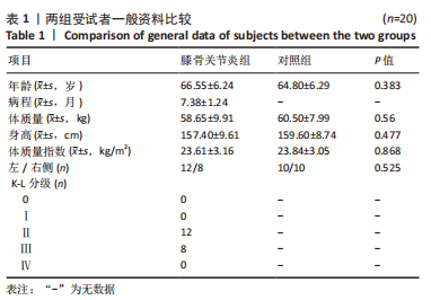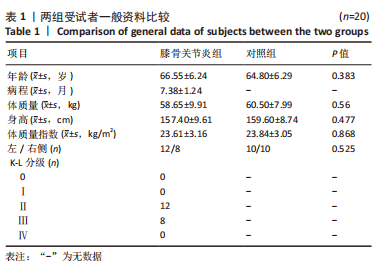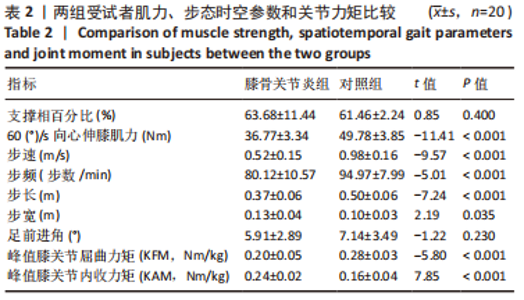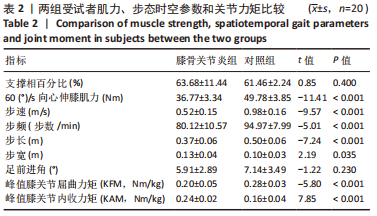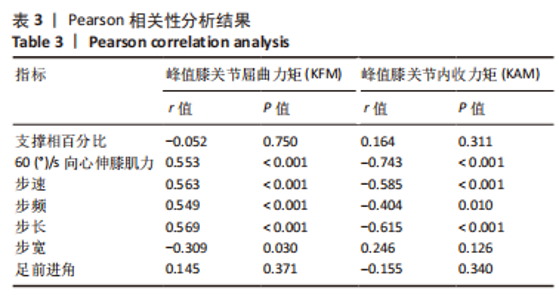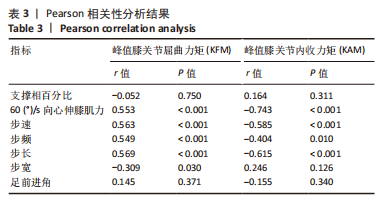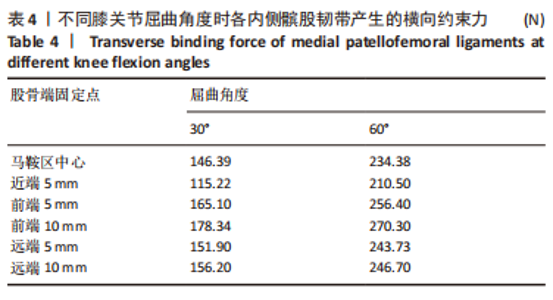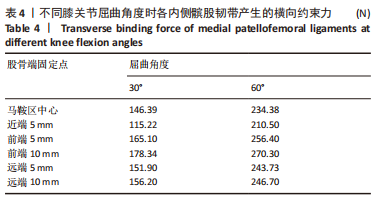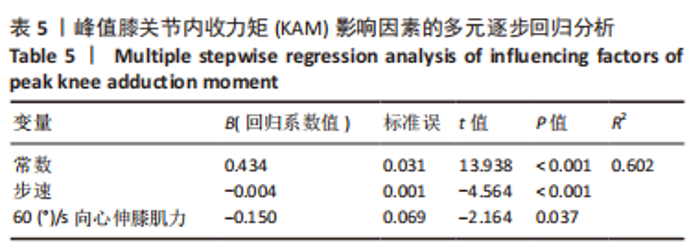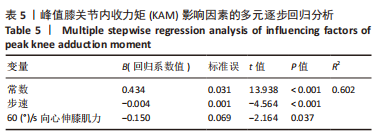Chinese Journal of Tissue Engineering Research ›› 2024, Vol. 28 ›› Issue (9): 1354-1358.doi: 10.12307/2023.902
Previous Articles Next Articles
Correlation of knee extensor muscle strength and spatiotemporal gait parameters with peak knee flexion/adduction moment in female patients with knee osteoarthritis
Li Yongjie1, Fu Shenyu1, Xia Yuan2, Zhang Dakuan1, Liu Hongju1
- 1Guizhou Hospital, Beijing Jishuitan Hospital, Guiyang 550014, Guizhou Province, China; 2Wuhan Sports University, Wuhan 430079, Hubei Province, China
-
Received:2022-12-12Accepted:2023-01-30Online:2024-03-28Published:2023-07-25 -
Contact:Liu Hongju, MD, Chief physician, Guizhou Hospital, Beijing Jishuitan Hospital, Guiyang 550014, Guizhou Province, China -
About author:Li Yongjie, Master, Rehabilitation therapist, Guizhou Hospital, Beijing Jishuitan Hospital, Guiyang 550014, Guizhou Province, China -
Supported by:Science and Technology Fund Project of Guizhou Provincial Health Commission in 2023, No. gzwkj2023-124 (to FSY)
CLC Number:
Cite this article
Li Yongjie, Fu Shenyu, Xia Yuan, Zhang Dakuan, Liu Hongju. Correlation of knee extensor muscle strength and spatiotemporal gait parameters with peak knee flexion/adduction moment in female patients with knee osteoarthritis[J]. Chinese Journal of Tissue Engineering Research, 2024, 28(9): 1354-1358.
share this article
Add to citation manager EndNote|Reference Manager|ProCite|BibTeX|RefWorks
| [1] ALENAZI AM, ALQAHTANI BA, VENNU V, et al. Gait Speed as a Predictor for Diabetes Incidence in People with or at Risk of Knee Osteoarthritis: A Longitudinal Analysis from the Osteoarthritis Initiative. Int J Environ Res Public Health. 2021; 18(9):4414. [2] BANNURU RR, OSANI MC, VAYSBROT EE, et al. OARSI guidelines for the non-surgical management of knee, hip, and polyarticular osteoarthritis. Osteoarthritis Cartilage. 2019;27(11):1578-1589. [3] METCALFE AJ, ANDERSSON ML, GOODFELLOW R, et al. Is knee osteoarthritis a symmetrical disease? Analysis of a 12 year prospective cohort study. BMC Musculoskelet Disord. 2012;13:153. [4] JONES RK, CHAPMAN GJ, FINDLOW AH, et al. A new approach to prevention of knee osteoarthritis: reducing medial load in the contralateral knee. J Rheumatol. 2013;40(3):309-315. [5] DE ROOIJ M, VAN DER LEEDEN M, HEYMANS MW, et al. Prognosis of Pain and Physical Functioning in Patients With Knee Osteoarthritis: A Systematic Review and Meta-Analysis. Arthritis Care Res (Hoboken). 2016;68(4):481-492. [6] BINDAWAS SM, VENNU V, AL SNIH S. Differences in health-related quality of life among subjects with frequent bilateral or unilateral knee pain: data from the Osteoarthritis Initiative study. J Orthop Sports Phys Ther. 2015;45(2):128-136. [7] CROSS M, SMITH E, HOY D, et al. The global burden of hip and knee osteoarthritis: estimates from the global burden of disease 2010 study. Ann Rheum Dis. 2014; 73(7):1323-1330. [8] 冯晓晴, 蔡道章, 余星磊,等. 基于GBD大数据中国膝骨关节炎疾病负担现状与趋势分析[J]. 现代预防医学,2022,49(10):1753-1760. [9] BLACK AL, CLARK AL. Sexual dimorphism in knee osteoarthritis: Biomechanical variances and biological influences. J Orthop. 2022;32:104-108. [10] EBERT JR, HAMBLY K, JOSS B, et al. Does an unloader brace reduce knee loading in normally aligned knees?. Clin Orthop Relat Res. 2014;472(3):915-922. [11] 张晶晶, 安丙辰, 郑洁皎. 足前进角改善膝骨关节炎症状及其机制的研究进展[J].中国康复理论与实践,2015,21(7):790-792. [12] BALIUNAS AJ, HURWITZ DE, RYALS AB, et al. Increased knee joint loads during walking are present in subjects with knee osteoarthritis. Osteoarthritis Cartilage. 2002;10(7):573-579. [13] THORP LE, SUMNER DR, WIMMER MA, et al. Relationship between pain and medial knee joint loading in mild radiographic knee osteoarthritis. Arthritis Rheum. 2007;57(7):1254-1260. [14] MIYAZAKI T, WADA M, KAWAHARA H, et al. Dynamic load at baseline can predict radiographic disease progression in medial compartment knee osteoarthritis. Ann Rheum Dis. 2002;61(7):617-622. [15] CHEHAB EF, FAVRE J, ERHART-HLEDIK JC, et al. Baseline knee adduction and flexion moments during walking are both associated with 5 year cartilage changes in patients with medial knee osteoarthritis. Osteoarthritis Cartilage. 2014;22(11): 1833-1839. [16] WALTER JP, D’LIMA DD, COLWELL CW Jr, et al. Decreased knee adduction moment does not guarantee decreased medial contact force during gait. J Orthop Res. 2010;28(10):1348-1354. [17] BARRIOS JA, HIGGINSON JS, ROYER TD, et al. Static and dynamic correlates of the knee adduction moment in healthy knees ranging from normal to varus-aligned. Clin Biomech (Bristol, Avon). 2009;24(10):850-854. [18] ALLET L, IJZERMAN H, MEIJER K, et al. The influence of stride-length on plantar foot-pressures and joint moments. Gait Posture. 2011;34(3):300-306. [19] FAVRE J, ERHART-HLEDIK JC, CHEHAB EF, et al. General scheme to reduce the knee adduction moment by modifying a combination of gait variables. J Orthop Res. 2016;34(9):1547-1556. [20] 乐意, 金荣疆, 阳杨,等.从下肢生物力学来解析膝骨关节炎[J].中国康复理论与实践,2013,19(6):505-509. [21] PIETROSIMONE B, DAVIS-WILSON HC, SEELEY MK, et al. Gait Biomechanics in Individuals Meeting Sufficient Quadriceps Strength Cutoffs Following Anterior Cruciate Ligament Reconstruction. J Athl Train. 2021;56(9):960-966. [22] 中华医学会骨科学分会关节外科学组, 中国医师协会骨科医师分会骨关节炎学组, 国家老年疾病临床医学研究中心(湘雅医院),等. 中国骨关节炎诊疗指南(2021年版)[J].中华骨科杂志,2021,41(18):1291-1314. [23] SPINOSO DH, BELLEI NC, MARQUES NR, et al. Quadriceps muscle weakness influences the gait pattern in women with knee osteoarthritis. Adv Rheumatol. 2018;58(1):26. [24] SCHWARTZ M H, ROZUMALSKI A. The Gait Deviation Index: a new comprehensive index of gait pathology. Gait Posture. 2008;28(3):351-357. [25] JOCHYMCZYK-WOźNIAK K, NOWAKOWSKA K, POLECHOńSKI J, et al. Physiological Gait versus Gait in VR on Multidirectional Treadmill-Comparative Analysis.Medicina (Kaunas). 2019;55(9):517. [26] 毕耕超, 张彦龙, 李秋月,等.不同高度和间距下跳深动作中膝关节力学和周围肌肉的激活特征[J]. 中国组织工程研究,2023,27(8):1211-1218. [27] 黄萍,王怡,陈博,等. 膝骨关节炎患者的三维运动解析[J].中国全科医学, 2020,23(17):2169-2176. [28] FREGLY BJ, REINBOLT JA, ROONEY KL, et al. Design of patient-specific gait modifications for knee osteoarthritis rehabilitation. IEEE Trans Biomed Eng. 2007; 54(9):1687-1695. [29] FOROUGHI N, SMITH R, VANWANSEELE B. The association of external knee adduction moment with biomechanical variables in osteoarthritis: a systematic review. Knee. 2009;16(5):303-309. [30] 张旻, 江澜. 内侧间室膝骨性关节的下肢关节生物力学变化[J]. 中国康复, 2011,26(1):36-38. [31] PALMIERI-SMITH RM, THOMAS AC. A neuromuscular mechanism of posttraumatic osteoarthritis associated with ACL injury. Exerc Sport Sci Rev. 2009;37(3):147-153. [32] HUANG C, CHAN P K, CHIU K Y, et al. Exploring the relationship between pain intensity and knee moments in participants with medial knee osteoarthritis: a cross-sectional study. BMC Musculoskelet Disord. 2021;22(1):685. [33] CREABY MW, HUNT MA, HINMAN RS, et al. Sagittal plane joint loading is related to knee flexion in osteoarthritic gait. Clin Biomech (Bristol, Avon).2013;28(8): 916-920. [34] TELFER S, LANGE MJ, SUDDUTH A. Factors influencing knee adduction moment measurement: A systematic review and meta-regression analysis. Gait Posture. 2017;58:333-339. [35] GUPTA D, DONNELLY CJ, REINBOLT JA. Finding Emergent Gait Patterns May Reduce Progression of Knee Osteoarthritis in a Clinically Relevant Time Frame.Life (Basel). 2022;12(7):1050. [36] FREGLY BJ, REINBOLT JA, CHMIELEWSKI TL. Evaluation of a patient-specific cost function to predict the influence of foot path on the knee adduction torque during gait. Comput Methods Biomech Biomed Engin. 2008;11(1):63-71. [37] SCHWAMEDER H, LINDENHOFER E, MüLLER E. Effect of walking speed on lower extremity joint loading in graded ramp walking. Sports Biomech. 2005;4(2):227-243. [38] DE DAVID AC, CARPES FP, STEFANYSHYN D. Effects of changing speed on knee and ankle joint load during walking and running. J Sports Sci.2015;33(4):391-397. [39] LAM WK, LEE KK, PARK SK, et al. Understanding the impact loading characteristics of a badminton lunge among badminton players. PLoS One. 2018;13(10):e0205800. [40] HALL M, WRIGLEY TV, METCALF BR, et al. Mechanisms underpinning the peak knee flexion moment increase over 2-years following arthroscopic partial meniscectomy. Clin Biomech (Bristol, Avon). 2015;30(10):1060-1065. [41] PALMIERI-SMITH RM, KREINBRINK J, ASHTON-MILLER JA, et al. Quadriceps inhibition induced by an experimental knee joint effusion affects knee joint mechanics during a single-legged drop landing. Am J Sports Med. 2007;35(8):1269-1275. |
| [1] | Wang Peiguang, Zhang Xiaowen, Mai Meisi, Li Luqian, Huang Hao. Generalized equation estimation of the therapeutic effect of floating needle therapy combined with acupoint embedding on different stages of human knee osteoarthritis [J]. Chinese Journal of Tissue Engineering Research, 2025, 29(8): 1565-1571. |
| [2] | Zhang Zixian, Xu Youliang, Wu Shaokui, Wang Xiangying. Effects of blood flow restriction training combined with resistance training on muscle indicators in college athletes: a meta-analysis [J]. Chinese Journal of Tissue Engineering Research, 2025, 29(8): 1705-1713. |
| [3] | Wang Juan, Wang Guanglan, Zuo Huiwu. Efficacy of exercise therapy in the treatment of anterior cruciate ligament reconstruction patients: #br# a network meta-analysis #br# [J]. Chinese Journal of Tissue Engineering Research, 2025, 29(8): 1714-1726. |
| [4] | He Guanghui, Yuan Jie, Ke Yanqin, Qiu Xiaoting, Zhang Xiaoling. Hemin regulates mitochondrial pathway of oxidative stress in mouse chondrocytes [J]. Chinese Journal of Tissue Engineering Research, 2025, 29(6): 1183-1191. |
| [5] | Ma Haoyu, Qiao Hongchao, Hao Qianqian, Shi Dongbo. Causal effects of different exercise intensities on the risk of osteoarthritis [J]. Chinese Journal of Tissue Engineering Research, 2025, 29(6): 1305-1311. |
| [6] | Wu Guangtao, Qin Gang, He Kaiyi, Fan Yidong, Li Weicai, Zhu Baogang, Cao Ying . Causal relationship between immune cells and knee osteoarthritis: a two-sample bi-directional Mendelian randomization analysis [J]. Chinese Journal of Tissue Engineering Research, 2025, 29(5): 1081-1090. |
| [7] | Li Jia, Liu Qianru, Xing Mengnan, Chen Bo, Jiao Wei, Meng Zhaoxiang. A network meta-analysis on therapeutic effect of different types of exercise on knee osteoarthritis patients [J]. Chinese Journal of Tissue Engineering Research, 2025, 29(3): 609-616. |
| [8] | Gou Yanyun, Hou Meijin, Jiang Zheng, Chen Shaoqing, Chen Xiang, Gao Yuzhan, Wang Xiangbin. Biomechanical characteristics of walking in patients with idiopathic scoliosis: cross-sectional analysis of three-dimensional motion capture [J]. Chinese Journal of Tissue Engineering Research, 2025, 29(3): 471-477. |
| [9] | Shi Lei, Shi Song, Lu Yue, Tao Ran, Ma Hongdong. Comparison of unicondylar knee arthroplasty and high tibial osteotomy in treatment of medial knee osteoarthritis [J]. Chinese Journal of Tissue Engineering Research, 2025, 29(3): 503-509. |
| [10] | Zheng Xiang, Zhang Mingxing, Huang Ya, Shan Sharui. Improvement of lower limb walking function in patients with chronic non-specific low back pain by biofeedback assisted electrical stimulation [J]. Chinese Journal of Tissue Engineering Research, 2025, 29(3): 547-553. |
| [11] | Zhang Qiming, Liao Di, Zhong Zhiliang, Lin Lihua, Zheng Xiang, Li Qiong, Shan Sharui. Effect of deep muscle stimulation combined with electromyographic biofeedback on the spasms of the triceps surae and gait changes after stroke [J]. Chinese Journal of Tissue Engineering Research, 2025, 29(2): 385-392. |
| [12] | Peng Yong, Hu Jiangping, Zhu Huan. Effects of low-load blood flow restriction exercise and high-intensity resistance exercise on the thigh microcirculation function of athletic young men [J]. Chinese Journal of Tissue Engineering Research, 2025, 29(2): 393-401. |
| [13] | Hu Xiaoshen, Li Huijing, Lyu Junling, Xiao Xianjun, Li Juan, Li Xiang, Liu Ling, Jin Rongjiang. Pathological changes in the total knee joint during spontaneous knee osteoarthritis in guinea pigs at different months of age [J]. Chinese Journal of Tissue Engineering Research, 2025, 29(11): 2218-2224. |
| [14] | Chen Wenhan, Men Jie, Yang Wei, Zhao Xiaoyu. Effect of vibration therapy combined with suspension training on movement and knee joint function after anterior cruciate ligament reconstruction [J]. Chinese Journal of Tissue Engineering Research, 2025, 29(11): 2225-2230. |
| [15] | Shen Xuyu, Luo Chengnuo, Zhang Xiaoyun, Jiang Zhouying, Chai Yuan . Role and mechanism of alkaloid components of traditional Chinese medicine against knee osteoarthritis [J]. Chinese Journal of Tissue Engineering Research, 2025, 29(11): 2368-2376. |
| Viewed | ||||||
|
Full text |
|
|||||
|
Abstract |
|
|||||
